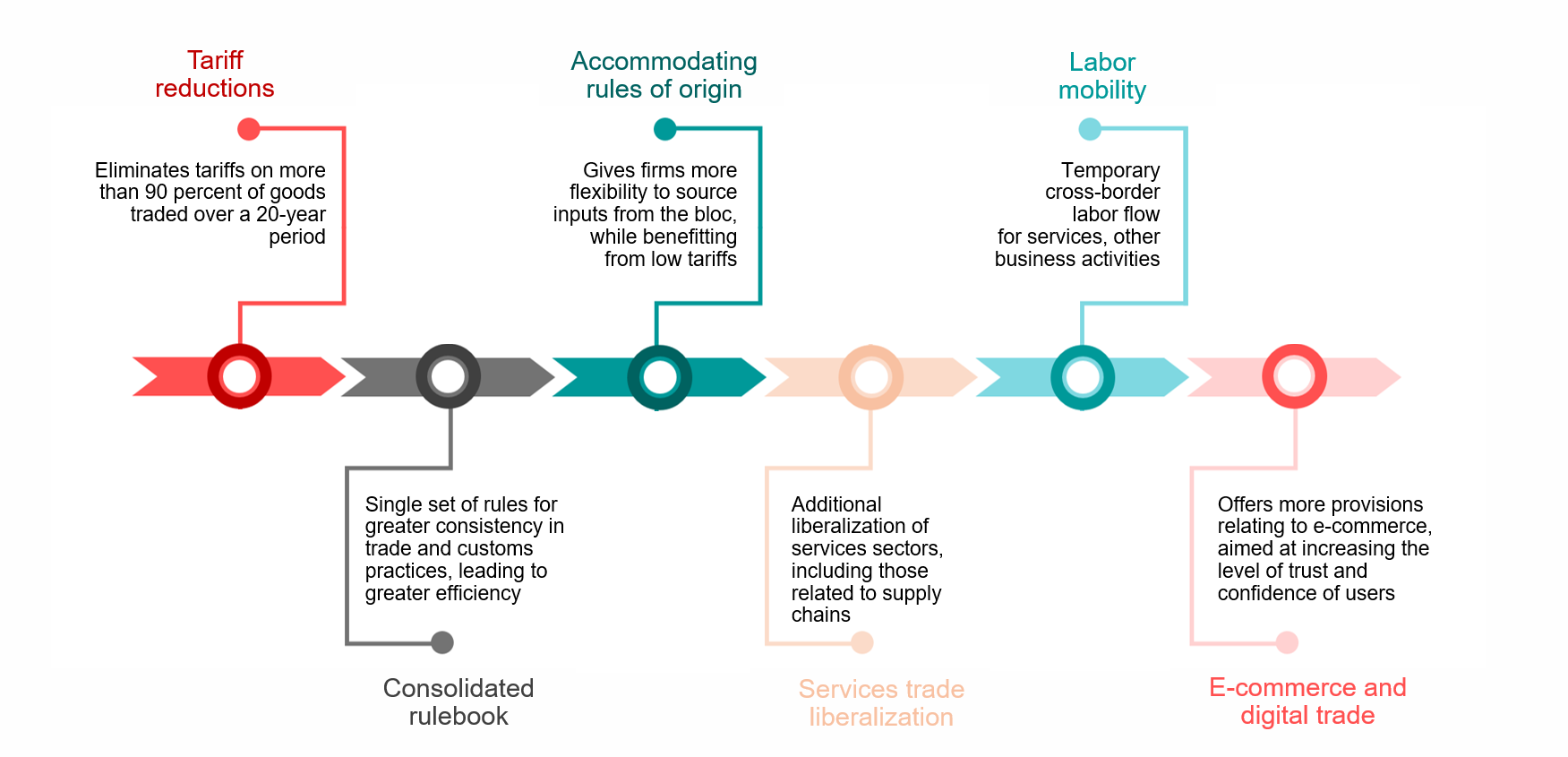The creation of the world’s largest free trade area materialized early this year, when the Regional Comprehensive Economic Partnership (RCEP) came into force on January 1, 2022. Encompassing 13 ASEAN+3 economies plus Australia and New Zealand, RCEP signals its members’ strong commitment to free trade and rules-based multilateralism and provides a timely opportunity to help boost their post-pandemic recovery.
Ten members (Australia, Brunei Darussalam, Cambodia, China, Japan, Lao PDR, New Zealand, Singapore, Thailand, and Vietnam) ratified the agreement before the start of the year, followed by Korea in February and Malaysia in March. Myanmar’s ratification was accepted by China in May and is pending acceptance by other members. Hong Kong, China applied to join RCEP in February 2022.
For ASEAN+3, RCEP is expected to create new trade and investment opportunities, strengthen regional supply chains, and promote new sources of growth.
So, exactly what gains are to be had from this momentous trade deal? We can think of three potential benefits stemming from RCEP’s key provisions (Figure).
The Regional Comprehensive Economic Partnership—Key Features

Source: AMRO staff.
The first—ostensibly most obvious—benefit would come from the elimination of tariffs on more than 90 percent of goods traded within the bloc over the next two decades.
The second—arguably more significant—benefit would come from efficiency gains from a consolidated trade rulebook and harmonized and more accommodating rules of origin compared to the different and overlapping requirements in the “noodle bowl” of bilateral “ASEAN+1” free trade agreements. Lower tariffs, harmonized requirements, and looser rules of origin will allow multinational enterprises to leverage the comparative advantages of different economies in ASEAN+3 to lower their cost of production. This will be a boon for regional supply chains. For example, low-cost manufacturers in ASEAN will be able to use high value-added inputs (e.g., semiconductors) from Japan or Korea, and their outputs can be imported tariff-free for further processing by China.
The third—often overlooked—benefit is the potential boost to cross-border services trade from the further liberalization of sectors such as telecommunications, financial services, modern services, and logistics, together with provisions on easier labor mobility and on e-commerce and digital trade. RCEP’s coverage of the latter—which is broader than the 2021 ASEAN Agreement on Electronic Commerce—will be especially critical as economies find new drivers of growth in a post-pandemic, more digitalized world.
Of course, while the agreement is expected to have an overall positive impact on long-term economic growth of the bloc, at the country level, individual economies will reap different benefits, and in different ways. RCEP tariff reductions, for example, will mainly benefit the Plus-3 economies of China, Japan, and Korea, which are now connected by a free trade agreement for the first time; ASEAN economies already enjoy largely free trade among themselves and with the other RCEP members via existing free trade agreements—less than 10 percent of ASEAN exports will see tariff reductions over the next 20 years. However, ASEAN economies would enjoy immediate efficiency gains from RCEP’s consolidated set of rules on trade and customs practices, and they are expected to benefit from higher investment flows deriving from expansion of the regional supply chains within the bloc over the medium term.
Will RCEP fully realize its promise? Yes, if all members are committed to do what it takes for greater and deeper trade integration.
As the ASEAN+3 economies emerge from the COVID-19 pandemic with scars that could be deep and long-lasting, there is a danger that their policy priorities could shift to become more inward-looking as they try to protect their domestic industries to shore up growth. However, if there is one thing the pandemic has taught us, it is how interdependent ASEAN+3 economies are—and strengthening our intra-regional links is the best bet for getting the region’s growth back on track post-pandemic. Economies that have not yet fully ratified the RCEP agreement—Indonesia and the Philippines—should not delay any further. Members should also remove any temporary trade barriers that were erected during the pandemic, and accelerate tariff and non-tariff-barrier reductions as much as possible to reap the benefits of RCEP’s positive impact on trade liberalization. And most importantly, they must adhere to the rules, disciplines, and commitments of the agreement to undertake the necessary—and often challenging—reforms, including those needed for liberalizing trade in services and cross-border e-commerce.
The signing of the RCEP agreement in January has already set the stage. It is up to the members—especially the ASEAN+3 economies—to make the most out of this opportunity.
This blog post is based on “Box 2.6: Deepening Economic Integration under the RCEP,” by Marthe Hinojales and Ling Hui Tan, in page 110 of the ASEAN+3 Regional Economic Outlook 2022.
